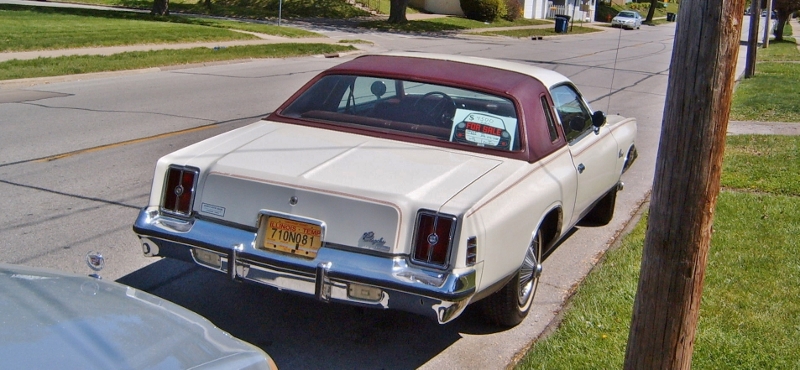
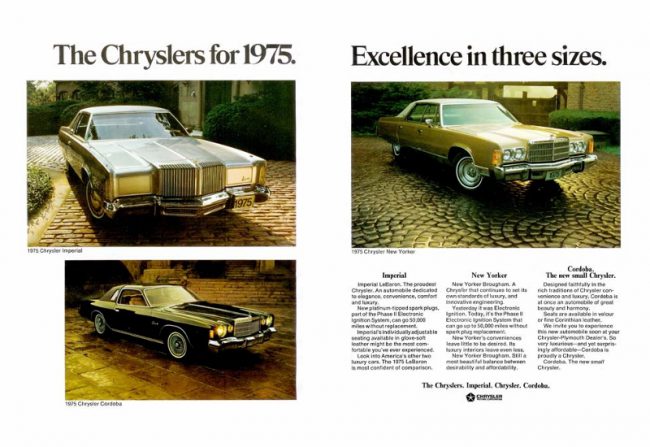
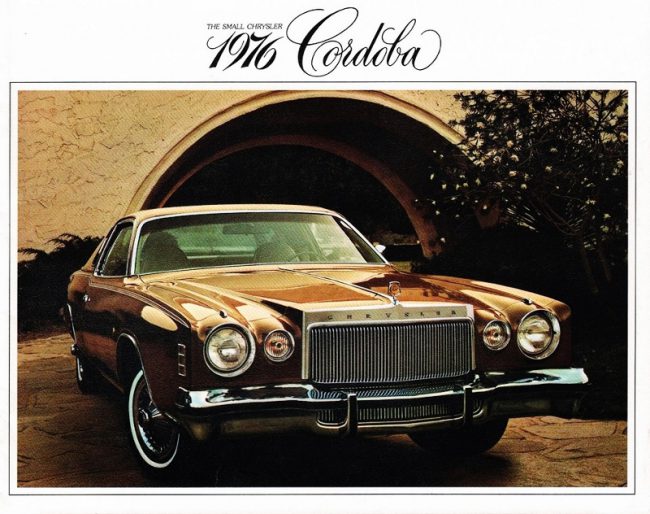
The Cordoba was Chrysler Corporation’s response to the burgeoning personal luxury car market, which hit its peak by mid-decade. For years, Chrysler Division had a “no small cars” policy and thus the entire lineup was land yachts: Newport, Newport Custom, Town & Country, New Yorker. But after the muscle car era declined due to increasing regulations, inflation and plain simple customer tastes, it was replaced with personal luxury cars such as the Pontiac Grand Prix, Chevy Monte Carlo and Oldsmobile Cutlass Supreme. Chrysler did not have an entry in this new and hot market, the closest model was the Charger SE, a Broughamified version of the Coke-bottled 1971 Charger. Something had to be done. The 1975 Cordoba was the answer.
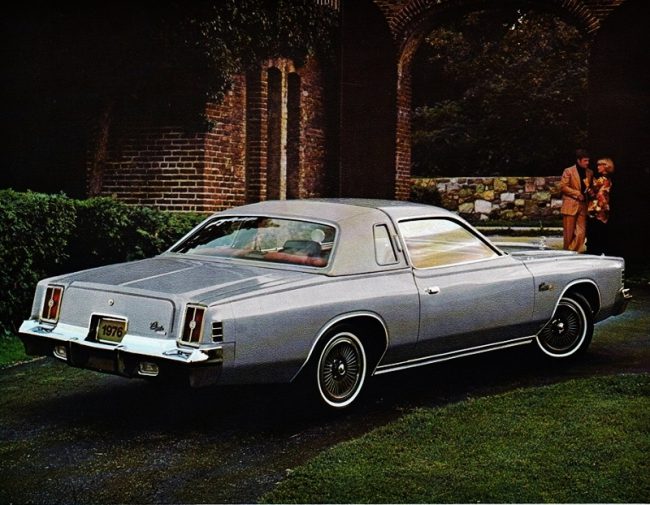
The Cordoba originated as a premium Plymouth coupe, but at the last minute, it was changed to a Chrysler. It was assumed that it would sell better – and at a higher price – as a Chrysler. The ’75 model had all of the mid-1970s personal-lux gotta-have-it items: shag carpet, power steering, power brakes, opera lamps, full vinyl or Landau-style top and available wire wheel covers. And let us not forget the soft Corinthian leather! Buckets and a console were available as well.
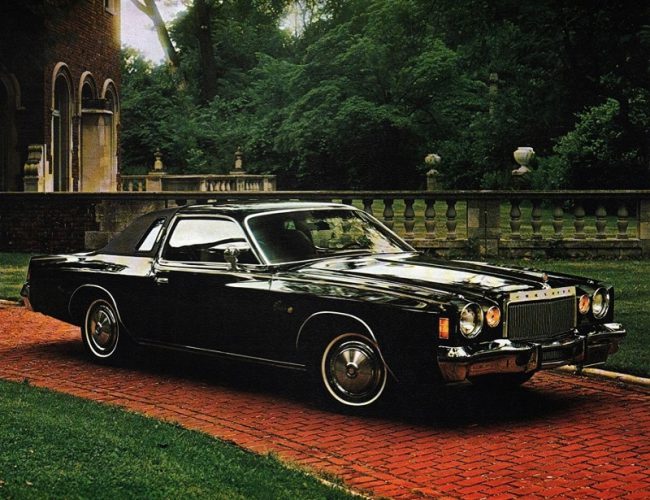
The Cordoba was based on the B-body Plymouth Fury and Dodge Coronet, perhaps most famous as 440 V8 powered police cars in myriad movies of the ’70s and ’80s, but had unique sheetmetal, a 114.9 inch wheelbase, and the longest doors in the industry, at 58.5″ long. It also had several neoclassic features, the most obvious being the tunneled headlamps and parking lamps. While it was meant to recall classic cars of the 1930s (and was also prominent on 1973-75 Chevrolet Monte Carlos) there was more than a passing resemblance to the contemporary Jaguar XJ6/XJ12. A two barrel, 150 hp 318 V8 was standard, with Torqueflite automatic transmission. A 400 V8 was available for an extra $73.
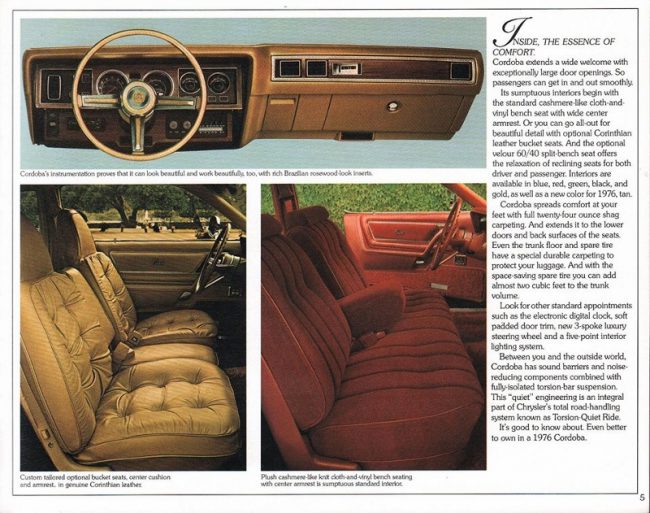
While the Dodge Charger Special Edition (the standard Chargers were basically Coronet coupes) was virtually identical to the $5581 Cordoba, it did not sell near as well as its corporate cousin. The flossier interiors and snob appeal of the Chrysler nameplate led to 150,105 Cordobas vs. 30,812 Charger SEs in 1975, despite a much lower price of $4903. The upper-crust name and the excellent marketing paid big dividends for Chrysler Corporation.
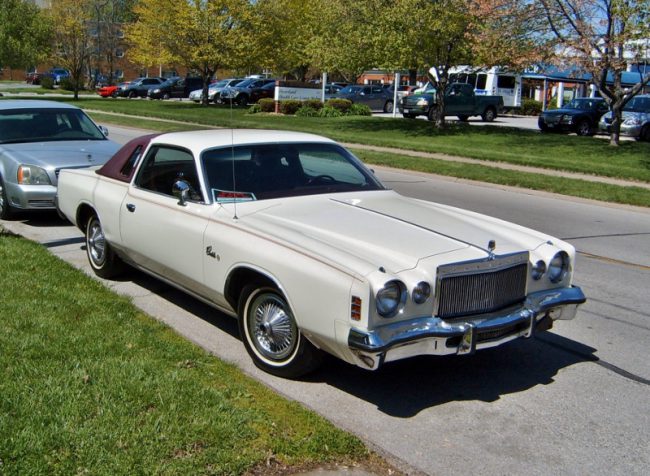
The Cordoba was a hit. Unfortunately, it was Chrysler Division’s only real bright spot for 1975, as sales of New Yorkers and Newports slid by 12% from 1974. Cordobas made up 60% of total 1975 Chrysler production. It was the right car at the right time.
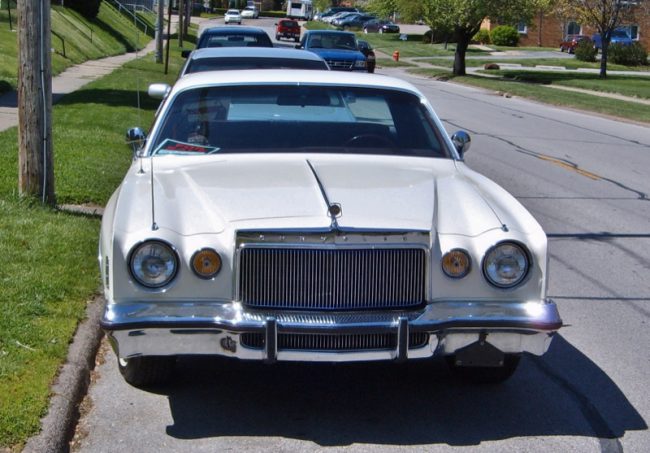
The 1975-78 Corboba was engineered in typical 1970s Chrysler fashion, with unibody construction and front torsion bar suspension. An optional Sure-Grip differential helped keep Cordobas from getting stuck in the snow. For its sophomore year, Chrysler wisely chose to not mess with success. The ’76 Cordoba was virtually identical, but sported a simple vertical bar grille instead of the ’75’s more ornate version.

While 1976 sales were not quite as high as 1975’s figure, it was still very good, with over 120,000 sold. It was Chrysler’s hot new product, and very different from the New Yorker Broughams, Town & Countrys and Newports it shared showrooms with.
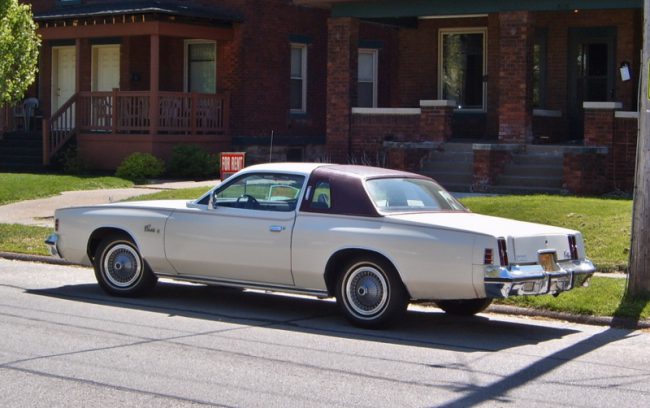
While even the basic Cordoba was a nice car in its time, there were naturally many, many optional comfort, convenience and appearance options. While all Cordobas came with opera windows and an opera lamp on the B-pillar, a “halo” full vinyl roof or landau roof could be added. I doubt many Cordobas were delivered with the standard steel roof. These cars were all about ‘the look’ and the Broughamier, the better. Pin stripes, contrasting top, wire wheel covers, stand-up hood ornament and chrome, chrome, chrome!
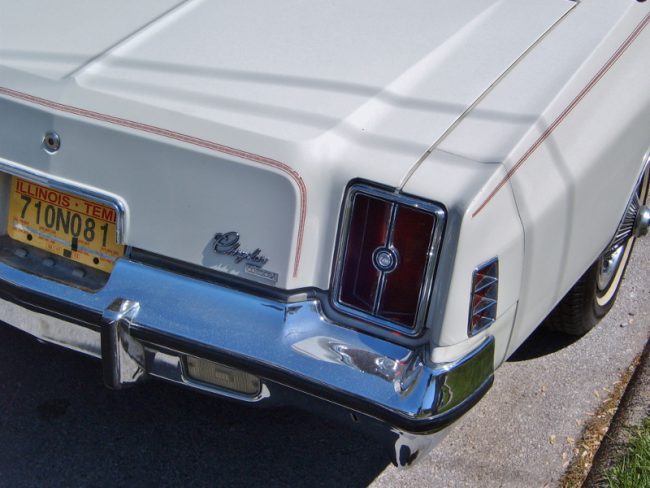
I first spotted our featured Cordoba on Easter Day back in The Year Of Our Lord 2012, as I was returning home from dinner at my parents’ house. It was dark, but I spotted it immediately while driving through Moline’s Olde Towne neighborhood. At the time, I hadn’t seen one of these since the mid ’90s, so I returned the very next day to capture it on film. But it was gone! Curses! But several days later, I finally spotted it again, in the very same parking spot.
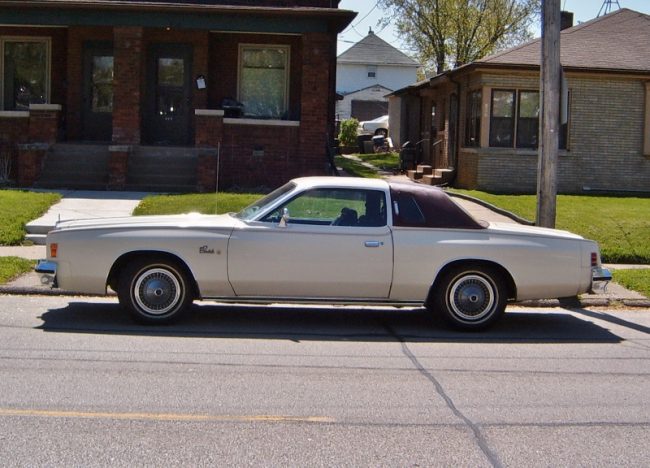
The ’76 is my favorite year of Cordoba. I like the simple vertical bar grille much better than the overdone ’75 and ’77 grilles. It hits all the Brougham-era luxury cues: landau roof, wire wheel covers, Spanish-doubloon type emblems, opera windows, and opera lamps. But the $64,000 question: Did it have fine Corinthian leather?
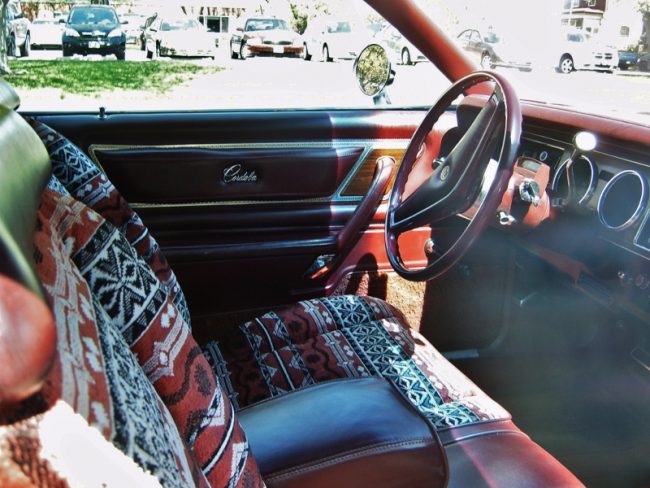
It did not. But this is clearly a 1970s personal luxury car interior. This was one of the several optional interiors (other choices included brocade, velour or leather), dubbed “Castillian” by Chrysler. It was apparently the industry’s first Jacquard interior upholstery. Personal luxury cars were for flashy people, and the interior choices reflected that. Oldsmobile had some equally wild interior fabrics on 1976-79 Cutlass Supreme Broughams.
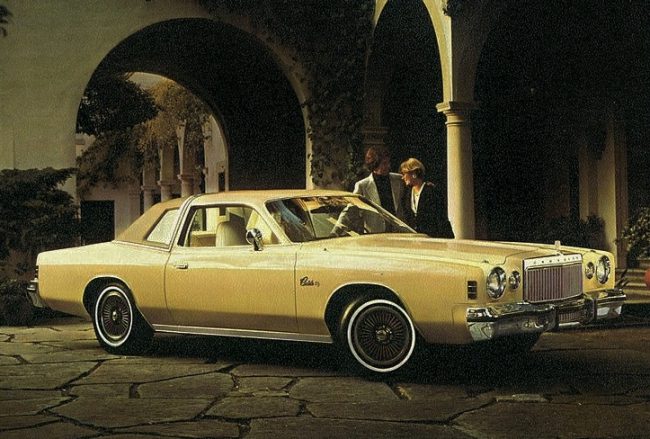
Cordoba’s appearance was little-changed for the 1977 model year, with the expected grille and tail light revisions. A new Crown landau top was introduced, however. Shown above, it featured a different window treatment and an illuminated band on the B-pillar. The light extended all across the top of the car and back down the other side. That must have made for a cool appearance at night!
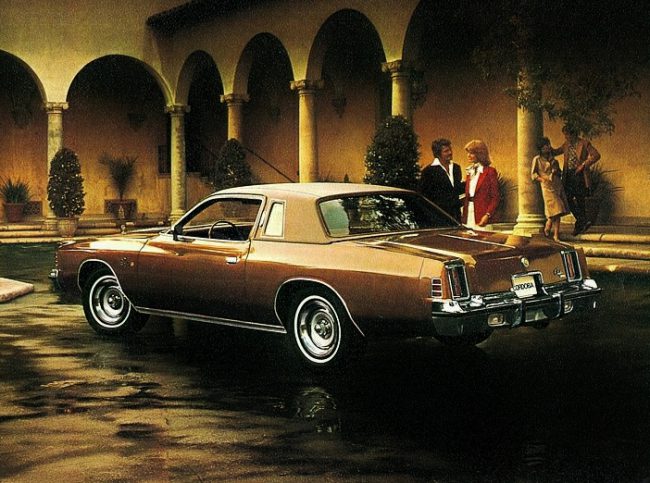
Of course, Ricardo Montalban remained the official Cordoba spokesman through the Cordoba’s run. He would remain in Chrysler advertising even after the Cordoba was discontinued in 1983. Does anyone else remember the Chrysler Crystal key commercials he did in the 1980s with Turbo K-car New Yorkers?
1977 was the last year the Cordoba wore its attractive tunneled headlights and parking lamps. 1977 was also the Cordoba’s best production year, with 183,146 produced.

As for the Cordoba itself, a somewhat questionable facelift in 1978 resulted in stacked quad headlamps and flatter, plainer tail lamps. While not bad looking, the 1975-77 was much better looking in your author’s opinion. The facelift also had the unfortunate effect of making the car look a lot like a 1976-77 Monte Carlo, at least from the front. Sales dipped to 124,825, but how much of that was due to its styling is questionable, as Chrysler was sliding into one of its periodic crises.
These Cordobas just screamed the ’70s personal lux glitz, and may well be the only car non-automotive people will remember. Just say “Corinthian leather” and they’ll know what you’re talking about!







10 Comments
I clearly remember the first Cordoba I had ever seen. I was 9 years old and in 3rd grade. It was Gina Mancini’s moms new car and I thought it was the coolest car! For some reason (probably Mr. Montalban) it really stood out. Hers was a rustyish gold color with a beige full vinyl top and interior. What a nice car I thought! I even got a ride home in it a few times. I was disappointed that hers had cloth interior but still it was exciting to be in a “CorDOUGHba”! They had that car for what seemed like forever!
True, Tom. Chrysler had hit the perfect nail on the head with their marketing – to this day people recall the “soft Corinthian leather” ads of the 70’s. Ricardo made it believable and made the Cordoba feel special. The Dodge Charger version, in my opinion, shouldn’t have even existed!
In a final note, in 1979, Mom was in the market to replace her ’72 Toronado. She loved the styling of the Cordoba (which I know for a fact was from Ricardo’s commercials) so Dad and I went with her to the local dealer to check one out. In the showroom was a chocolate brown one with the rare tan crown roof and tan leather interior Cordoba….just the color combo Mom loved! I was psyched…this will be Mom’s new car……until the blue suited cigarette smelling obnoxious salesman came over to us, had Mom get in the car and then proceeded to slam the door. When he did the window nearly exploded, coming off the track and smashing down into the door. Mom nearly screamed and we ordered her Riviera the next day! True story!
One thing that seemed to be improved on the Cordoba was noise control. B bodies before had been rightly criticized for poor control of road, wind, and engine noise. Fixing that created a situation making possible a competitive full size off the B in 79.
I love seeing the ads from the 70s, not just for Montebaun but for that surprising stylish Tudor architecture in the background. It looked so much better then when upscale homes came with decent size lots.
All that and “Corinthian leather” to boot! I had no idea what that was back then, but Ricardo made it sound speeeeee-shul! 🙂
Near car, but it’s no Matador.
The Barcelona?
Ah yes..”rich Cor-EEEN-thian leatherrrrrrrrrr!”
Here is the better Cordoba commercial, with the man who could sell ice to Eskimos — Ricardo Montalban:
In the mid-70’s, ChryCo was in a world of hurt. They were smacked hard by the oil embargoes of 1973-74 and having mostly larger cars throughout the USDM lineup, there was little recourse. The ‘Doba came at a crucial time. More than one commentator has noted that the Mustang II was the perfect car for Ford at the right time. The Cordoba was about a year later, but couldn’t have been better for ChryCo and especially Chrysler division at that time. I really can’t imagine what would have become of ChryCo if the Cordoba hadn’t been the hit that it was. The idea to shift the car from Plymouth to Chrysler division was one of the better ones until the advent of the minivan, IMO.
I was an early teenaged kid when these hit the market, but judging by my older brothers’ reaction to the car, it was something special. And within a year or so (especially in our heavily GM influenced town) these were making their mark on the streets. My middle school basketball coach had one of the original ones in that burgundy color that was so popular. He would give some of us kids rides home (he lived nearby) that I got some seat time in those models. I had grown up in mid sized Ford products, I had experienced full sized Cadillacs and their luxury from that period, but I had no idea that a working stiff could afford a mid sized car jam-packed with so many luxury features.
Even to this day, the car cuts such a nice profile. How the Mopar stylists made such a pig’s ear (Charger) out of the silk purse (Cordoba) is beyond me. The era that arguably had the worst quality and workmanship from Chrysler is my favorite era for some odd reason. Whether Fury, Charger or Cordoba, I wouldn’t kick one of these out of my garage. The Cordoba would be my first choice…
I have a light blue/white top 1976 Charger that I’ve owned since 2004. I daily drove it for a couple years, taking it on summer vacations to the beach and making many memories. I eventually parked it, then a few years later took it apart and restored it (still needs a paint job but it look OK). It now has a warmed up cam solid valvetrain 360 with FiTech EFI, an 8-3/4 and it really only comes out for bracket racing events for which it actually won an event this past summer. It’s followed me across the country and will soon follow me back. I look at this blue baggage and wonder why I still have it sometimes. It’s not worth enough to sell and the comments when I take it out are entertaining. You certainly don’t see any other late B-bodies at the track.
Two comments:
1) “Corinthian leather” is actually a term of art for “leather” that is reconstituted leather scraps pressed together with a binder. In other words, the absolute bottom rung of quality in the world of upholstery leather. Magically, it was converted via a South American accent from the equivalent of “look! genuine imitation fake vinyl wood grain!” to something perceived as desirable.
2) No matter how the Chrysler marketeering department told us to pronounce it in the 70s, the FIRST syllable of Cordoba is the one that’s accented.
For that matter, I wonder if Ricardo Montalban might actually have been born Richard Bergstrom of Minneapolis, before the hair dye and accent were applied?